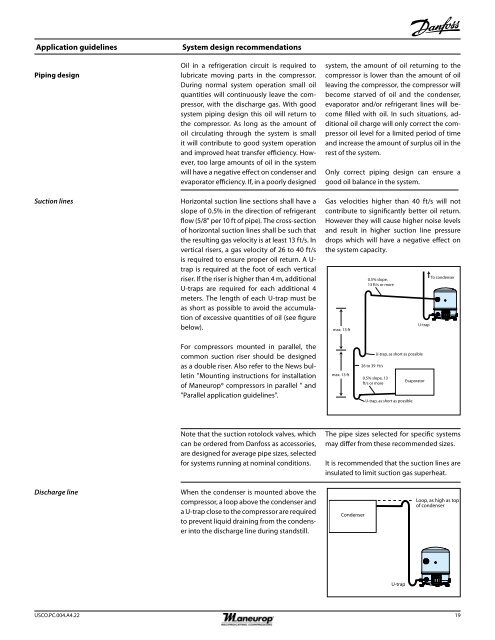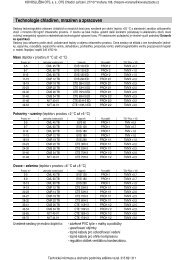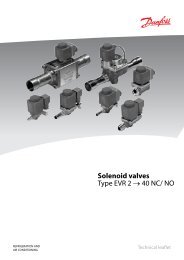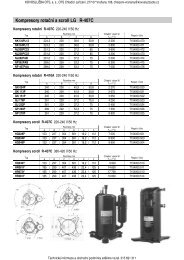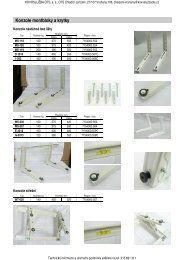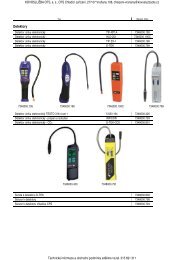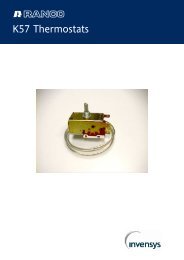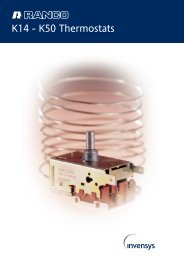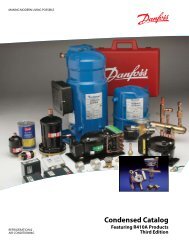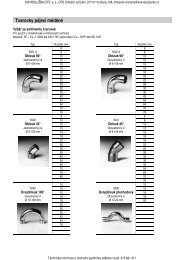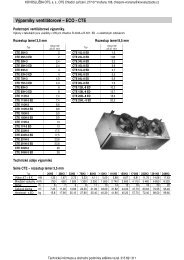Maneurop® reciprocating compressors
Maneurop® reciprocating compressors
Maneurop® reciprocating compressors
You also want an ePaper? Increase the reach of your titles
YUMPU automatically turns print PDFs into web optimized ePapers that Google loves.
Application guidelines<br />
Piping design<br />
Suction lines<br />
System design recommendations<br />
Oil in a refrigeration circuit is required to<br />
lubricate moving parts in the compressor.<br />
During normal system operation small oil<br />
quantities will continuously leave the compressor,<br />
with the discharge gas. With good<br />
system piping design this oil will return to<br />
the compressor. As long as the amount of<br />
oil circulating through the system is small<br />
it will contribute to good system operation<br />
and improved heat transfer efficiency. However,<br />
too large amounts of oil in the system<br />
will have a negative effect on condenser and<br />
evaporator efficiency. If, in a poorly designed<br />
Horizontal suction line sections shall have a<br />
slope of 0.5% in the direction of refrigerant<br />
flow (5/8" per 10 ft of pipe). The cross-section<br />
of horizontal suction lines shall be such that<br />
the resulting gas velocity is at least 13 ft/s. In<br />
vertical risers, a gas velocity of 26 to 40 ft/s<br />
is required to ensure proper oil return. A U-<br />
trap is required at the foot of each vertical<br />
riser. If the riser is higher than 4 m, additional<br />
U-traps are required for each additional 4<br />
meters. The length of each U-trap must be<br />
as short as possible to avoid the accumulation<br />
of excessive quantities of oil (see figure<br />
below).<br />
system, the amount of oil returning to the<br />
compressor is lower than the amount of oil<br />
leaving the compressor, the compressor will<br />
become starved of oil and the condenser,<br />
evaporator and/or refrigerant lines will become<br />
filled with oil. In such situations, additional<br />
oil charge will only correct the compressor<br />
oil level for a limited period of time<br />
and increase the amount of surplus oil in the<br />
rest of the system.<br />
Only correct piping design can ensure a<br />
good oil balance in the system.<br />
Gas velocities higher than 40 ft/s will not<br />
contribute to significantly better oil return.<br />
However they will cause higher noise levels<br />
and result in higher suction line pressure<br />
drops which will have a negative effect on<br />
the system capacity.<br />
max. 13 ft<br />
0.5% slope,<br />
13 ft/s or more<br />
For <strong>compressors</strong> mounted in parallel, the<br />
common suction riser should be designed<br />
as a double riser. Also refer to the News bulletin<br />
"Mounting instructions for installation<br />
of <strong>Maneurop®</strong> <strong>compressors</strong> in parallel " and<br />
"Parallel application guidelines".<br />
max. 13 ft<br />
26 to 39 ft/s<br />
0.5% slope, 13<br />
ft/s or more<br />
Note that the suction rotolock valves, which<br />
can be ordered from Danfoss as accessories,<br />
are designed for average pipe sizes, selected<br />
for systems running at nominal conditions.<br />
The pipe sizes selected for specific systems<br />
may differ from these recommended sizes.<br />
It is recommended that the suction lines are<br />
insulated to limit suction gas superheat.<br />
Discharge line<br />
When the condenser is mounted above the<br />
compressor, a loop above the condenser and<br />
a U-trap close to the compressor are required<br />
to prevent liquid draining from the condenser<br />
into the discharge line during standstill.<br />
USCO.PC.004.A4.22 19


